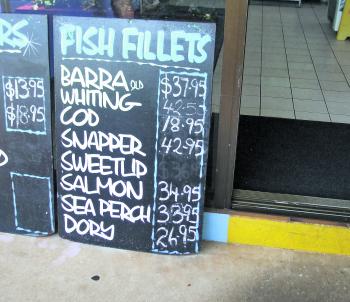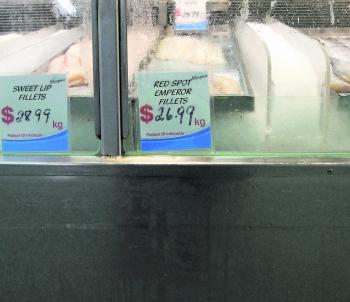The first weekend of winter certainly set us up for a change. Up until then we had still been experiencing mild nights and warm days. In years gone by the bream would have been around in significant numbers by now but this year they hadn’t put in much of an appearance. I anticipate the wet will change things up.
Over the last 20 years, and more significantly because of the current media circus around the declaration of the three northern net free areas, one of the arguments against the nets is always, “where will people who don’t fish get their fish and chips?” This is not a new argument and we have prepared data over a significant period of time to provide clear information with respect to Moreton Bay against the unfounded allegations that without nets there will be no access for locals to buy fish.
Unscrupulous retailers in the north even cleared window space and put signs there saying this is what would happen after the net free areas were enacted. They also claimed that no one would be able to buy barramundi anymore. Not surprisingly, that hasn’t happened.
In 2014-15 38.1% of Queensland Fisheries production was from aquaculture. The main two species were prawns and barramundi. In fact, 2,930.9 tonnes of aquaculture barramundi were produced in 2014-15 compared to only 687.95 tonnes of wild caught barramundi.
Sunfish Queensland has commissioned three retail surveys from 1999-2016 to ascertain the amount of local fish that reach our retail outlets and what the price affordability was over that same period as well. The 2016 survey was done in April/May to provide a seasonal variation to previous surveys. All outlets in each of the surveys were restricted to the Brisbane Region only – from Bribie to Logan. The surveys were commenced as a result of numerous statements from individuals and the public commenting on the lack of local fresh seafood available and the increase of interstate and imported fish at a lower price.
The terms of reference for the survey were to ascertain; the availability, type, form, origin and cost of current fish products available to the public in the survey area. To compare the results with our previous surveys in 1999 and 2012. And to ascertain how much and what species were supplied locally by the commercial sector for purchase by the public.
Generally local and interstate species were advertised as Australian product with exceptions such as ‘Hervey Bay’ scallops and ‘Tasmanian’ salmon etc. Some imported product indicated country of origin such as barramundi (Taiwan), smoked cod (South Africa), snapper (NZ). Most were just labelled as ‘imported’. Only one outlet actually had defined labelling practices.
Common local fish such as fresh whole whiting, bream, flathead and snapper were only stocked by 20% or less of outlets. The range of generally available interstate product had increased due to the larger range of inshore species such as mullet, bream, whiting, tailor, luderick, and mulloway identified as sourced from NSW, and deep water species such as gold band snapper (NT).
The range of generally available imported products had remained stable with previously high volume products losing market share to Hoki. Asian imports of milkfish and tilapia appeared in 20% of the outlets.
Queensland coral reef and rocky reef fish species varied in availability and were not consistently stocked. (Local pearl perch was available in one outlet only).
The products most stocked in outlets were – Atlantic salmon (13 outlets), mullet and barramundi (7), South African smoked cod (8), Prawns in various forms (13).
There is a trend to filleted product rather than whole and this was more noticeable in interstate and imported product. Where fresh whole local fish was stocked there was generally the same species in filleted form and for sale as cooked fish. Imported product was generally frozen with approximately 20% whole and 80% fillets. They were generally in sealed packets/boxes. Local crustaceans (prawns, crabs) were almost totally sold as whole animals (green or cooked). Stocking of interstate shellfish such as oysters and mussels has increased
Generally, as expected all prices have increased, but local product (8.5%) had increased more than interstate and imported product (1%). Some local product had increased by 20-50%, which is well above average. Coral trout fillets were $50/kg compared to fresh Atlantic salmon fillets at $33 and frozen basa fillets at $8. The lowest cost product per kilo for whole fish was mullet at $6, trevally and tilapia at $10, and milkfish at $9. For fillets, blue grenadier ($13), basa ($8), and mullet ($11) were the cheapest. Mussels ($10) and Bay Prawns ($16) were the lowest cost product in the crustacean/shellfish division.
The highest cost products per kilo for whole fish items included coral trout ($37), NZ snapper ($21), summer whiting ($21), flathead ($18), and mud crabs ($30). The highest cost of filleted species was summer whiting ($42), barramundi ($35), snapper ($40), red emperor ($43). And in the crustaceans/shellfish category cooked large king and tiger prawns ($33), Moreton Bay bugs ($40), scallops ($80) were the highest cost. All Queensland products had a 16% increase.
The statement that commercial operators supply the public has only limited validity, as local inshore product availability was low – only 30% stocked one or more local fish species and mullet predominated. In most cases the cost was well above interstate and imported product – prime fish was very expensive, with whiting fillets costing $42, snapper fillets at $40, coral trout fillets at $50, scallops at $80, red emperor fillets at $57, and mud crabs at $30 – making them a luxury.
Local whole product that was generally of a lower price was whole mullet at $7, bay prawns at $10-15, all of which are of a low recreational catch importance and generally a specific bulk caught commercial fish.
Recreational local fish such as snapper, pearl perch, whiting, bream, tailor, swallowtail, mackerel, and coral reef fish were generally not available for sale Only three shops sold whole fresh Queensland coral reef fish, which was limited collectively to only 5 main species.
If volume sales in all supermarkets could be assessed (at Coles, Woolworths, IGA), it would be expected that interstate and imported products would greatly exceed local fresh product,
The quality of the product varied and often reflected the listed price difference between the outlets. In several outlets the product was obviously days old and some had two grades for the same species that reflected the ‘shelf life’ difference. Most of the specialist seafood outlets could be considered excellent areas to purchase well-presented and fresh product. There was little advertising of whether the frozen product had been thawed or not. Supermarket and specialist seafood outlet labelling was generally more accurate, but lacked specific origin details except when promoting high price product, for example, Hervey Bay export grade scallops at $107/kg. No ‘unfrozen’ product had catch or use by dates.
Product availability was spread in a similar pattern in all surveys with not all surveyed outlets stocking similar products. Product availability differed between surveys.
The average increase for all local fish product where comparisons could be made was 8.5%. The average increase for all interstate products where comparisons could be made was 1%. The average increase for all imported products where comparisons could be made was 1%.
The average current price for scotch fillet steak is $30/kg, which equates to $2.70 per portion of protein. Whiting fillets are $42/kg equates to $4.83 per portion of protein. Most families can’t afford to regularly eat scotch fillet steak so that certainly makes whiting well out of the reach of most.
Seafood outlets in the greater Brisbane area are stocking very little Moreton Bay fish, and most of what is stocked is outside of the budget of the average local family. Therefore, removing gillnets from Moreton Bay will have no significant impact on the supply of fresh fish to those locals who are unable to catch their own. The full printed report will be available shortly.
Facts
Sources
Agriculture, Fisheries and Forestry in Queensland, 2015. Research by the Australian Bureau of Agricultural and Resource Economics and Sciences.
www.eatforhealth.gov.au
Percentage of outlets that supply fish based on species
| Species | 1999 | 2012 | 2016 |
|---|---|---|---|
| Mullet | 60% | 64% | 55% |
| Whiting | 50% | 20% | 15% |
| Barramundi | 30% | 57% | 55% |
| Snapper | 40% | 43% | 20% |
| Sand Crabs | 40% | 50% | 70% |
Standard serve of protein
65g cooked lean red meats such as beef, lamb, veal, pork, goat or kangaroo (about 90-100g raw)
80g cooked lean poultry such as chicken or turkey (100g raw)
100g cooked fish fillet (about 115g raw)

This photo on the left shows the price of local whiting and barra at $37.95 and $42.50/kg respectively. By comparison the photo on the right shows red spot emperor and sweet lip fillets imported from Indonesia at a reduced cost – $26.99 and $28.99 re

This photo on the left shows the price of local whiting and barra at $37.95 and $42.50/kg respectively. By comparison the photo on the right shows red spot emperor and sweet lip fillets imported from Indonesia at a reduced cost – $26.99 and $28.99 respect




